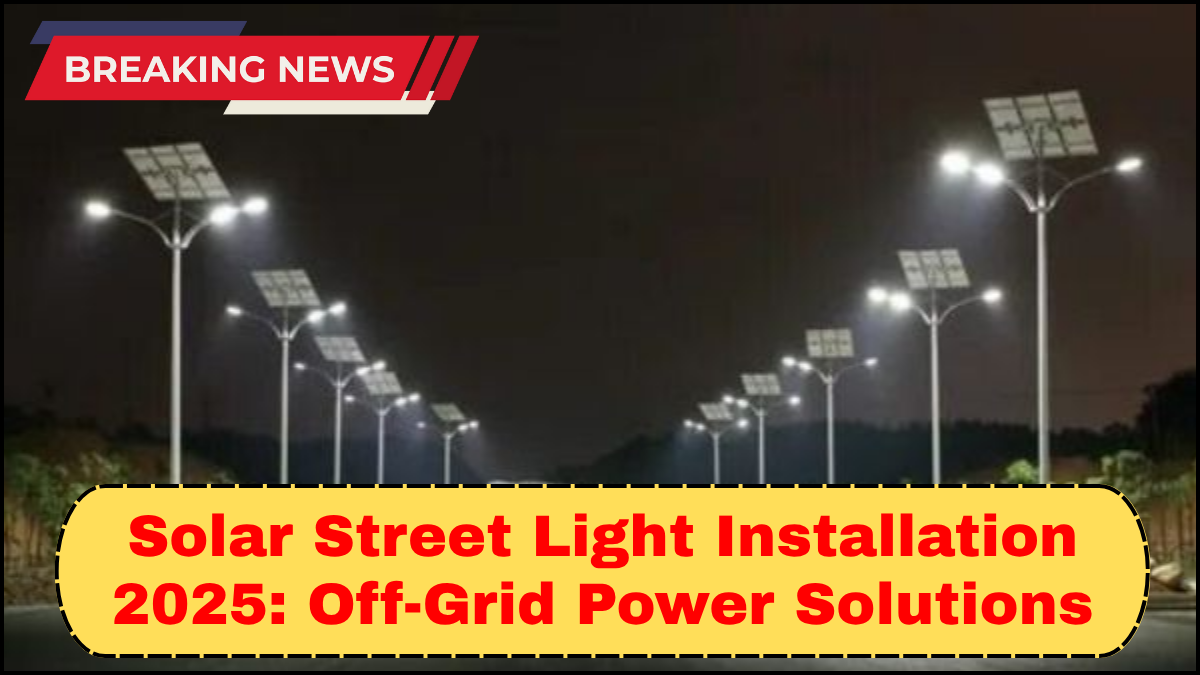The global push toward sustainability has accelerated the adoption of solar street lights, particularly in off-grid and remote areas. As we move into 2025, the emphasis on renewable energy and decentralized infrastructure has made solar street light installation not only a smart investment but a strategic necessity. Whether you’re a city planner, business owner, or rural developer, understanding the ins and outs of off-grid lighting solutions is essential.

Here’s a comprehensive Solar Street Light Installation Guide tailored for 2025, covering every angle from planning to execution.
Why Off-Grid Lighting Solutions Are Gaining Ground
Off-grid lighting solutions eliminate the need for traditional electrical infrastructure, making them perfect for areas without reliable grid access. These systems are powered entirely by solar energy, stored in batteries, and used during nighttime hours.
Key benefits include:
-
Independence from grid failures: Even during blackouts, these lights remain operational.
-
Cost-effective in the long run: After installation, they incur minimal operating expenses.
-
Eco-friendly: Zero emissions, lower carbon footprint.
-
Ideal for remote areas: No trenching or cabling required, cutting down civil work costs.
Planning for Solar Street Light Installation in 2025
Before jumping into installation, detailed planning ensures optimal performance and cost-efficiency. Here’s what to consider:
1. Site Assessment and Requirements
Evaluate the area where the lighting system is to be installed. Consider factors such as:
-
Sunlight availability (minimum 4-6 hours of direct sun)
-
Shadows from trees or buildings
-
Local weather patterns
-
Required lighting levels based on application (pedestrian pathways, highways, parking lots)
2. Choosing the Right System
Not all solar street lights are the same. Selecting the appropriate system based on your project’s requirements is crucial. Options include:
-
All-in-one systems: Compact and easy to install, great for small-scale or residential areas.
-
Split systems: Better heat dissipation and larger capacity, ideal for heavy-duty or urban projects.
Ensure the system includes quality components like:
-
Monocrystalline or polycrystalline solar panels
-
Lithium-ion or LiFePO4 batteries
-
LED light with high lumen output
-
Smart controllers with dusk-to-dawn features
Installation Process: Step-by-Step Guide
Here’s a detailed breakdown of how to install a solar street lighting system:
1. Foundation Preparation
Dig the pole foundation based on design specifications. Standard depth is around 1 to 1.5 meters, depending on soil condition and wind speed in the area.
2. Pole and Component Assembly
Install the pole, ensuring it’s upright and stable. Then mount the solar panel, LED lamp, battery, and controller. In all-in-one systems, these components are typically pre-integrated, speeding up the process.
3. Wiring and Configuration
Connect the solar panel to the battery through the charge controller. Connect the battery to the LED lamp. Set the controller according to lighting preferences (timing, brightness levels).
4. Testing and Commissioning
Once installed, allow the system to charge for at least a full day before first use. Test the light at night to ensure it turns on automatically and functions as expected.
Maintenance Tips for Longevity
Although solar street lights require minimal maintenance, a few simple steps can keep them running optimally:
-
Clean solar panels regularly to remove dust and debris.
-
Check battery health annually.
-
Inspect pole and mountings for rust or wear.
-
Update firmware in smart controllers if applicable.
Real-World Applications in 2025
From refugee camps in Africa to smart cities in Europe, off-grid solar lighting is transforming public infrastructure:
-
Disaster relief zones rely on rapid-deploy solar lights for security and visibility.
-
Smart city projects integrate IoT-enabled solar street lights with sensors for traffic and air quality monitoring.
-
Agricultural and rural zones use them to light roads, improve safety, and boost local economies.
Key Trends to Watch in 2025
-
AI-Powered Lighting Systems: Adaptive brightness based on human activity.
-
Solar + Wind Hybrid Systems: Dual-power solutions for cloudy or low-sunlight regions.
-
Modular Designs: Easy upgrades and scalable lighting options.
-
Carbon Credit Integration: Governments offering incentives for solar adoption.
FAQs
Q1: How long does a solar street light last?
A: Most high-quality systems last between 8–12 years, with batteries typically needing replacement every 5–7 years.
Q2: Can solar street lights work during cloudy or rainy days?
A: Yes. Modern systems store enough energy to operate for 2–5 days without sunlight, depending on the battery capacity.
Q3: Are there government incentives for solar street light installation in 2025?
A: Many countries offer subsidies, tax rebates, or carbon credit benefits. Check local energy policy updates for eligibility.
Q4: Is professional installation necessary?
A: While some systems are plug-and-play, larger or commercial installations benefit from expert setup to ensure efficiency and safety.
Q5: What are the maintenance costs?
A: Very low. Occasional panel cleaning and periodic checks are usually sufficient.
click here to learn more



